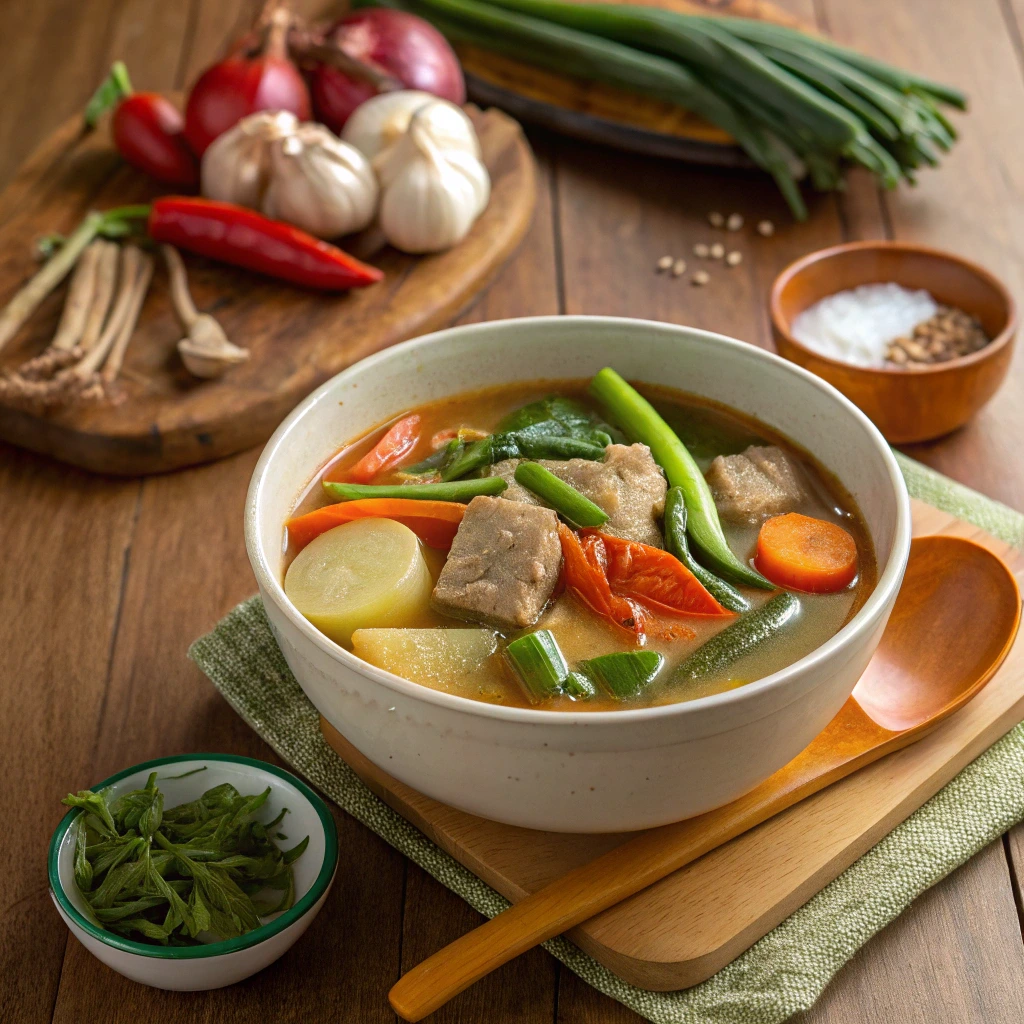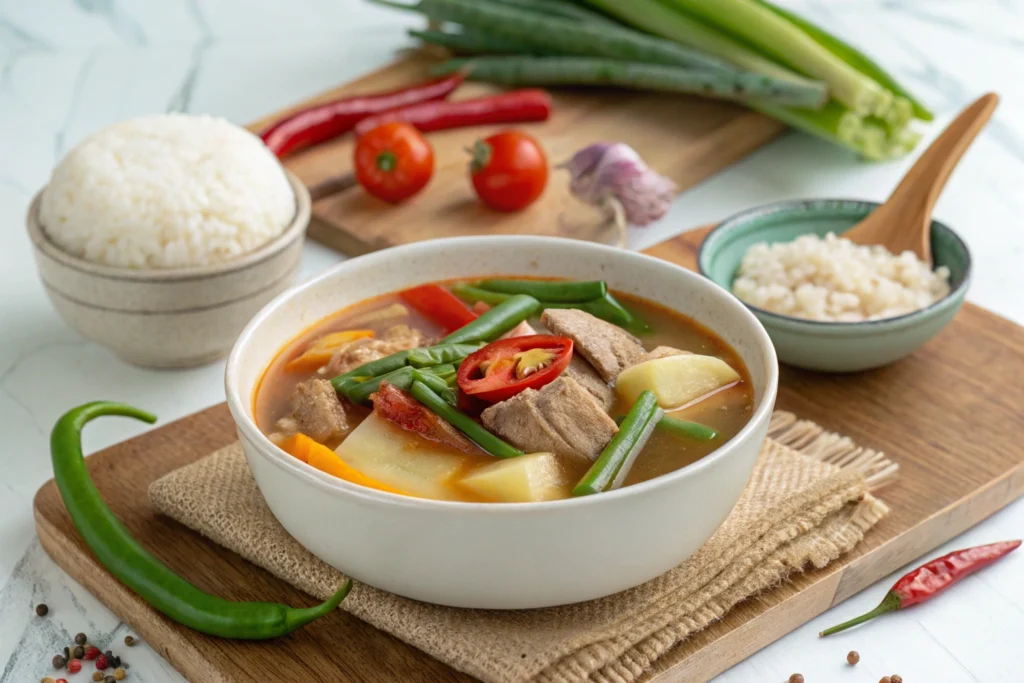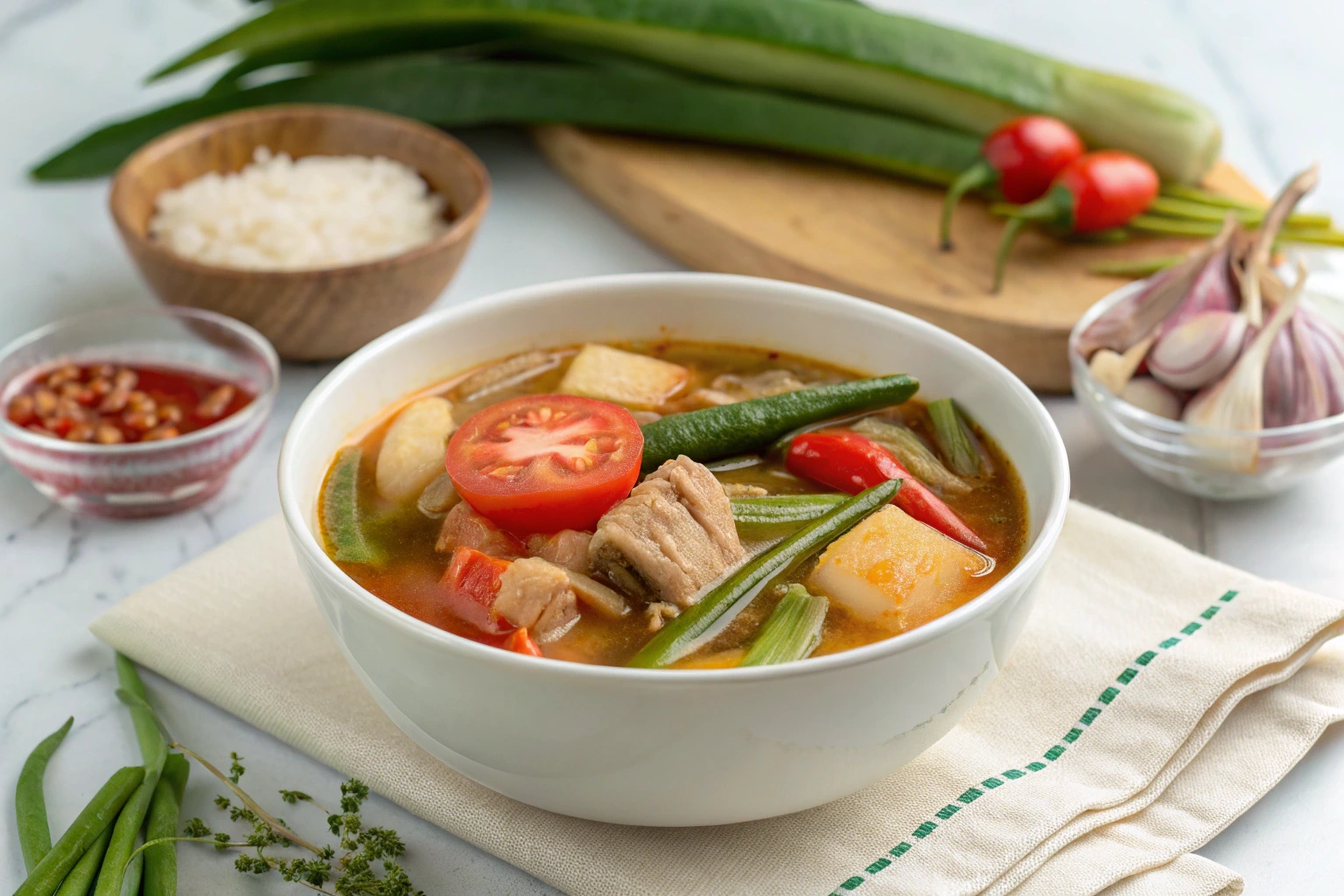Sinigang recipe, a classic Filipino comfort food, is known for its bold and tangy flavor. This savory, sour soup has been a beloved dish in Filipino households for generations. The soup’s main feature is its delightful sourness, which is typically derived from tamarind, making it a truly unique and comforting meal. It’s versatile, allowing for different proteins like pork, beef, shrimp, or even fish, and paired with an array of delicious vegetables. Whether you’re craving something warm for a rainy day or looking to bring some Filipino flavor to your kitchen, Sinigang is the perfect dish to satisfy those tastes.
In this blog post, we’ll walk you through how to make the best Sinigang recipe, using traditional ingredients, and give you helpful tips to elevate your dish. Let’s dive into this mouth-watering Filipino classic!
What is Sinigang?
Introduction to Sinigang recipe as a Traditional Filipino Dish
Sinigang is a sour soup that has been part of Filipino cuisine for centuries. It’s made from a base of tamarind, which gives it its signature tart flavor, and is usually served with rice. Sinigang is not just a meal; it’s a comforting dish that evokes memories of family gatherings and shared meals. It can be cooked with various meats such as pork, beef, or shrimp, making it a versatile dish that suits every taste.
In the Philippines, Sinigang is often enjoyed during the rainy season as it provides warmth and comfort. It’s also typically served as a main dish and often accompanies rice, which complements the richness of the soup’s broth.
Overview of Sinigang’s Popularity and Cultural Significance
Sinigang is one of the most iconic dishes in Filipino cuisine, celebrated for its bold and unforgettable flavor. It has gained recognition beyond the Philippines, with Filipino communities worldwide enjoying this comforting soup. It has become an emblem of Filipino hospitality and is often served to guests, symbolizing the warmth of Filipino culture.
The dish has evolved over time, and while tamarind remains the primary source of sourness, variations have emerged using different fruits like guava or pineapple to give the soup a unique twist. This flexibility in flavor makes Sinigang a highly customizable dish that appeals to a wide range of tastes.
The Role of Tamarind in Sinigang’s Distinctive Sour Flavor
The tamarind plays a crucial role in the flavor profile of Sinigang. Its tartness is the foundation of the soup, offering the right balance of sourness and tang. Traditionally, fresh tamarind pods were used, but today, tamarind paste or instant Sinigang mix can also be used for convenience.
Though tamarind is the most common souring agent, the introduction of fruits like guava or calamansi (Filipino lime) has led to variations that provide a distinct twist to the classic recipe, with each variation adding its own level of complexity.
Essential Ingredients for the Best Sinigang recipe
To create the perfect Sinigang, you’ll need a few key ingredients that come together to create its iconic flavor. Here’s a breakdown of the essentials:
**Protein Choices: Pork (Pork Belly, Ribs), Shrimp, Beef (Short Ribs), or Fish
Sinigang can be made with different proteins, and the choice largely depends on your preference or what you have available. The most common protein used in Sinigang is pork, specifically pork belly or pork ribs, which add richness to the broth.
Alternatively, beef short ribs are another popular choice, offering a more robust flavor. If you’re looking for something lighter, shrimp can be used, offering a delicate sweetness that complements the sour broth. For a more traditional approach, bangus (milkfish) or other local fish can also be used to create a unique and flavorful Sinigang.
Tamarind: The Key Ingredient for the Sour Base
Tamarind is the star ingredient in Sinigang. It provides the soup with its signature tang and sourness. You can use fresh tamarind pods by boiling them to extract the pulp, or you can use tamarind paste or Sinigang mix, which are convenient alternatives. If you want a slightly milder sourness, you can balance the tamarind with a bit of sugar.
Vegetables: Kangkong (Water Spinach), Eggplant, Radish, String Beans, and Okra
A variety of vegetables is used in Sinigang to add texture and depth. The most common vegetables are:
- Kangkong (water spinach), which adds a leafy green element to the dish.
- Eggplant, which softens beautifully in the broth and absorbs the flavor.
- Radish (labanos), providing a subtle sweetness and crunch.
- String beans (sitaw) for a slight bitterness that complements the sour broth.
- Okra, which adds a bit of sliminess to the dish that some people love.
These vegetables are added at different stages of cooking to ensure they retain their flavor and texture.
Seasoning: Fish Sauce, Tomatoes, Onions, and Long Green Chili for Added Depth
To season the Sinigang, fish sauce is commonly used for its salty umami flavor, while tomatoes and onions provide a sweet and aromatic base for the broth. Adding a few long green chili peppers (siling pang-sarap) gives the soup a subtle heat without overwhelming the flavor.
Step-by-Step Guide to Making the Best Sinigang recipe

Now that you have your ingredients, it’s time to make the perfect Sinigang. Follow these easy steps for a delicious and authentic dish:
Preparing the Broth: Tamarind Paste or Fresh Tamarind for Flavor
Start by preparing the tamarind. If you’re using fresh tamarind pods, boil them in water for about 20 minutes until the pulp becomes soft. Once cooled, remove the seeds and strain the liquid to extract the sour juice. If using tamarind paste or Sinigang mix, dissolve it in water according to the package instructions.
Cooking the Protein: How to Prepare Pork, Shrimp, or Beef
Add your chosen protein to the pot and let it simmer. If you’re using pork ribs, cook them for about 45 minutes to 1 hour until they become tender. For shrimp, a quick 5-minute boil will be enough to ensure they’re cooked through. For beef, simmer for 1.5 to 2 hours until the meat is tender.
Adding the Vegetables: When and How to Add Each Vegetable
Once the protein is tender, it’s time to add the vegetables. Start by adding the radish and eggplant, which take longer to cook. After about 10 minutes, add the string beans, okra, and kangkong. Let everything cook together for another 5 to 10 minutes, depending on how soft you prefer the vegetables.
Adjusting Seasoning: Balancing Sourness, Saltiness, and Heat
Taste the broth and adjust the seasoning as needed. Add fish sauce for saltiness, sugar if you want to reduce the sourness, and a long green chili for a bit of heat. You can also add extra tomatoes or onions for more depth of flavor.
Tips for the Perfect Sinigang Every Time

Using Fresh Tamarind vs. Instant Sinigang Mix
While fresh tamarind offers the most authentic and vibrant flavor, using instant Sinigang mix can be a convenient alternative. If you use the mix, make sure to taste the broth as you go, as some mixes can be saltier or more concentrated than others.
Adjusting the Sourness: How to Make It More Tangy or Mild
The level of sourness in Sinigang can be adjusted based on your preference. To make it tangier, add more tamarind or use sour fruits like guava or calamansi. If you prefer a milder sourness, reduce the tamarind and balance it with sugar or additional vegetables.
Common Mistakes to Avoid: Overcooking the Vegetables, Using the Wrong Cut of Meat
Overcooking the vegetables can result in a mushy texture, so it’s important to add them at the right time. Also, avoid using cuts of meat that are too lean, as they won’t provide the rich, flavorful broth that Sinigang is known for.
How to Store and Reheat Leftovers for the Best Taste
Sinigang tends to taste even better the next day as the flavors meld together. Store leftover Sinigang in an airtight container in the refrigerator for up to 3 days. To reheat, gently warm the soup on the stove, adding extra water or broth if needed.
Serving and Enjoying Sinigang
Traditional Ways to Serve Sinigang recipe (With Rice and Dipping Sauce)
Sinigang is traditionally served with steamed rice, which helps balance the sourness of the broth. It’s also common to have bagoong (fermented shrimp paste) or fish sauce as a dipping sauce on the side, allowing you to add an extra layer of flavor to each bite.
Pairing Sinigang with Filipino Side Dishes
Sinigang pairs wonderfully with other Filipino side dishes like fried fish, grilled meats, or a fresh ensalada (Filipino tomato and cucumber salad). These sides provide additional textures and flavors that complement the tangy, savory broth.
Creative Variations: Adding Fruit Like Pineapple or Guava for a Twist
For a unique twist on the classic Sinigang, try adding pineapple or guava to the soup. These fruits contribute a natural sweetness that balances the tanginess of the tamarind and adds complexity to the dish.
Conclusion
Sinigang is a timeless Filipino dish that combines simple ingredients with bold flavors. Whether you’re preparing it with pork, beef, shrimp, or fish, Sinigang delivers a comforting and satisfying experience that brings people together. By following the steps and tips in this guide, you can create the perfect bowl of Sinigang every time. Adjust the sourness to your liking, use the freshest ingredients, and enjoy this heartwarming Filipino classic with your loved ones.
So, grab your tamarind, your favorite protein, and get ready to experience the ultimate comfort food—Sinigang!
Also learn How to Make Mexican Macaroni Salad: A Quick and Easy Recipe

